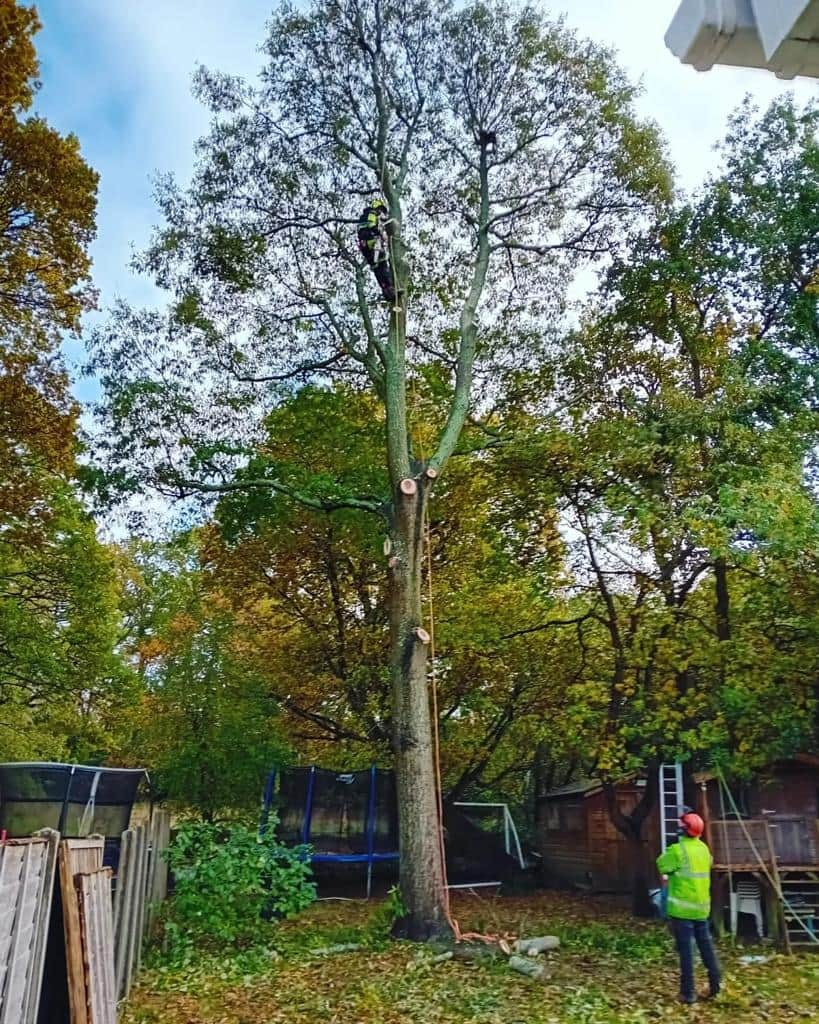Introduction
Trees are a valuable part of any landscape. They offer shade, privacy, wildlife habitat, and beauty—but there are times when keeping a tree poses more risk than benefit. At LM Tree Surgery Liphook, we often help clients in Hampshire assess whether a tree should be preserved, pruned, or—when necessary—completely removed.
While felling a tree may feel drastic, there are very real situations where cutting it down is the safest, most responsible option. In this post, we’ll explore 11 clear scenarios where removing a tree isn’t just recommended—it’s essential.
Key Takeaways
- Tree removal is sometimes necessary for safety, property protection, or environmental reasons.
- Early intervention can prevent damage to homes, driveways, or neighbouring trees.
- Ignoring key warning signs may lead to costly or dangerous consequences.
- Professional assessment ensures trees are only removed when absolutely required.
1. The Tree Is Dead
This might sound obvious, but it’s worth stating clearly—a dead tree should be removed immediately. Once a tree dies, it begins to decay from the inside out. The trunk and limbs become brittle, posing a high risk of falling during storms or even mild winds. Dead trees also attract pests and fungi, which can spread to healthy plants nearby.
2. Major Structural Damage
Cracks in the trunk, splitting bark, or significant lean often point to irreparable structural failure. If a tree is no longer stable or has lost its core integrity, it becomes a hazard. Even if it’s still alive, the risk of collapse makes removal the safest course of action.
3. It’s Causing Damage to Foundations or Pipes
Some trees have aggressive root systems that stretch far beyond the canopy. Over time, these roots can invade drainage pipes, lift paving slabs, or destabilise building foundations. If root management hasn’t worked and damage continues, removing the tree may be the only viable solution.
4. The Tree Is Severely Diseased
While many tree diseases can be treated with early intervention, some become too advanced. Trees suffering from diseases like honey fungus, canker, or Dutch elm disease may decline rapidly and become structurally unsafe. Infected trees also pose a threat to nearby healthy specimens and should be removed to contain the spread.
5. It’s Blocking Essential Light or Space
If a tree is casting too much shade over your property, garden, or even solar panels, it may be affecting the growth of other plants—or reducing your home’s energy efficiency. While pruning might help, in some cases the entire tree must go to open up the space properly.
6. It’s Leaning Dangerously
A tree that’s begun to lean—especially suddenly—is a major red flag. It could signal root failure, soil erosion, or storm damage. If the lean is towards your home, a neighbour’s property, or a public path, removal becomes urgent to avoid injury or legal complications.
7. It’s Too Close to Power Lines or Structures
Trees growing too close to houses, garages, fences, or overhead cables are a long-term risk. As they mature, the branches may interfere with power supplies or physically damage nearby structures. If pruning no longer keeps the growth in check, complete removal may be necessary.
8. Storm or Wind Damage Has Compromised It
After extreme weather, trees may suffer from broken limbs, split trunks, or root upheaval. Even if the damage isn’t immediately obvious, internal weakness can worsen over time. A professional inspection will determine whether the tree can be saved—but in many cases, felling is the safest option.
9. It’s Creating a Safety Hazard for Pedestrians or Vehicles
In busy areas—near driveways, footpaths, or roads—a large or low-hanging tree can pose a danger to passing pedestrians, parked cars, or delivery vehicles. If the tree obstructs visibility or presents fall hazards, it often must be removed for safety and access.
10. It’s Outgrowing the Available Space
Not every tree suits every location. What started as a manageable sapling may eventually overwhelm the space it occupies, growing too close to property lines, drainage systems, or other trees. When a tree becomes unmanageable due to sheer size, especially in smaller gardens, removal is sometimes the only reasonable route.
11. The Tree Is Preventing Renovation or Development
Sometimes, construction plans—like building an extension, new driveway, or garden redesign—mean a tree is unfortunately in the way. While it’s always worth exploring design adjustments first, there are instances where a tree’s location makes development impossible. In these cases, removal clears the path for necessary upgrades to your property.
Conclusion
Tree removal isn’t about destroying nature—it’s about protecting people, property, and the health of the overall landscape. At LM Tree Surgery Liphook, we’re committed to helping homeowners make informed, responsible decisions about their trees.
If you’re concerned about a tree on your property—whether it’s showing signs of decay, encroaching on structures, or simply growing out of control—it’s best to act early. Contact us today for expert advice and honest assessments. Sometimes, removing one tree is what’s needed to protect everything else you value.
Call us on: 01428 770 498
Click here to find out more about LM Tree Surgery Liphook
Click here to complete our contact form and see how we can help with your tree’s needs.

